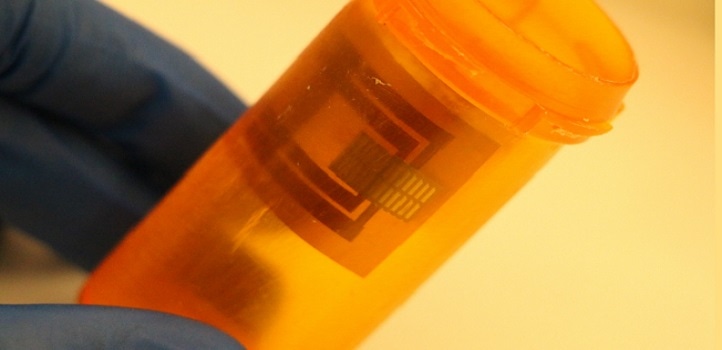May 7 2019
A smart pill bottle that gives wireless alerts on sensing overdose, tampering, or insecure storage conditions is one among the several promising health applications for a new sensor technology being created by a research group at KAUST.
 A flexible computer inside a medication bottle can send wireless SMS messages when someone attempts to tamper with it. (Image credit: 2019 Muhammad M. Hussain)
A flexible computer inside a medication bottle can send wireless SMS messages when someone attempts to tamper with it. (Image credit: 2019 Muhammad M. Hussain)
Digital technology provides possibilities to enhance conventional methods to problems endangering human health. For instance, networks of small wearable sensors set up in hospitals can be employed to trace influenza outbreaks in real time. However, the high costs related to electronic manufacturing makes these sensors unavailable where they are most required, such as the low-income populations that suffer unduly from epidemics.
Muhammed Hussain, doctoral student Sherjeel Khan, and colleagues are trying to develop sensors that are more accessible using cheaper materials. For instance, they recently showed that it is possible to develop humidity and temperature sensors from paper by drawing circuits using conductive ink.
The group has currently made a stretchy sensor—an anisotropic conductive tape with a variety of touch-sensitive applications. The new material is arranged by placing tiny silver particles in between two layers of adhesive copper tape. It is nonconductive in its normal state; however, when pressed by a finger, the double-layered tape makes an electrical contact that transmits a signal to an external reader.
Similar devices have been used in flat panel displays, but we’ve made them simple to build and easy to use by almost anyone.
Sherjeel Khan, Doctoral Student, KAUST
The scientists used their technology to develop a smart pill bottle to help combat the issue of prescription drug abuse. After 3D-printing a lid that employs light-emitting diodes to calculate the number of pills given out, they stuck paper-based humidity and temperature sensors to its base. The bottle was subsequently covered with an outer layer of conductive tape that functions as a touch sensor.
If someone tries to break into the bottle, or if the insides are dangerously dampened, a flexible control module inside the bottle analyzes the signals and offers warnings to cell phones through a Bluetooth connection. The conductive tape could be employed separately or as part of a modular sensor system, and hence, Hussain predicts it could help teams searching for rapid tests of innovative health sensors.
This sensor development that is simple to create also offers wider opportunities for scientists.
If you give researchers a ‘do it yourself opportunity’, there is a good chance they will use it to expand the horizon of electronics and empower humanity with better technology.
Muhammed M. Hussain, Professor, KAUST
S4 - Pill Counter Demo
This smart pill bottle tells caregivers when a patient may have taken too much or not enough medication. (Video credit: 2019 Muhammad M. Hussain)